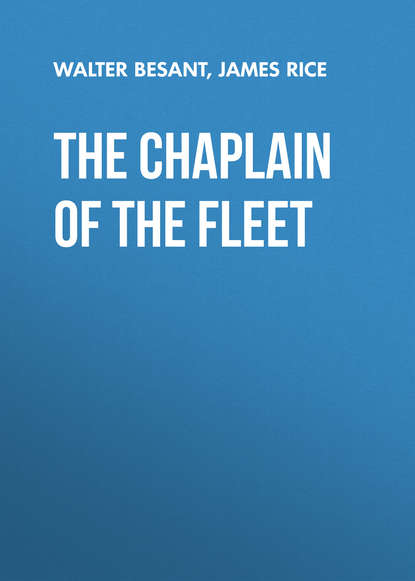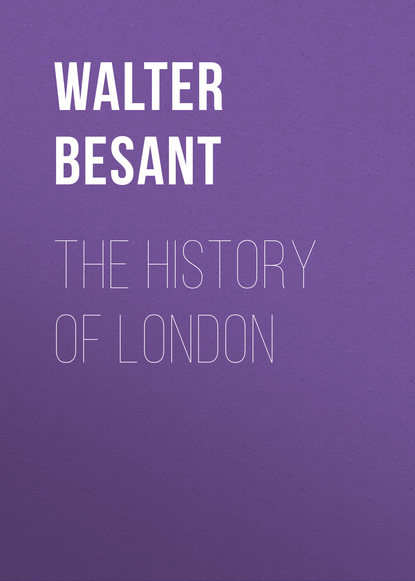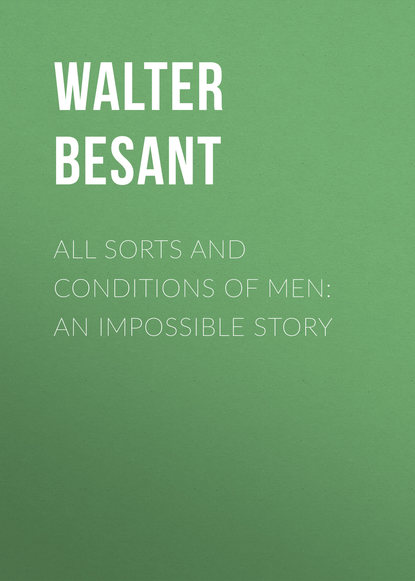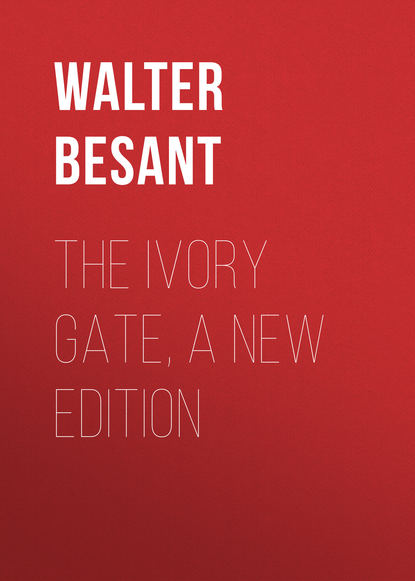
Полная версия
South London

Sir Walter Besant
South London
PREFACE
In sending forth this book on 'South London,' the successor to my two preceding books on 'London' and 'Westminster,' I have to explain in this case, as before, that it is not a history, or a chronicle, or a consecutive account of the Borough and her suburbs that I offer, but, as in the other two books, chapters taken here and there from the mass of material which lies ready to hand, and especially chapters which illustrate the most important part of History, namely, the condition, the manners, the customs of the people dwelling in this place, now, like Westminster, a part of London: yet, until two or three hundred years ago, an ancient marsh kept from the overflowing tide by an Embankment, joined to the Dover road by a Causeway, settled and inhabited by two or three Houses of Religious: by half a dozen Palaces of Bishops, Abbots, and great Lords: by a colony of fishermen living on the Embankment from time immemorial, since the Embankment itself was built: and by a street of Inns and shops.
I hope that 'South London' will be received with favour equal to that bestowed upon its predecessors. The chief difficulty in writing it has been that of selection from the great treasures which have accumulated about this strange spot. The contents of this volume do not form a tenth part of what might be written on the same plan, and still without including the History Proper of the Borough. I am like the showman in the 'Cries of London' – I pull the strings, and the children peep. Lo! Allectus goes forth to fight and die on Clapham Common: William's men burn the fishermen's cottages: little King Richard, that lovely boy, rides out, all in white and gold, from his Palace at Kennington – saw one ever so gallant a lad? The Bastard of Falconbridge bombards the city: Sir John Fastolfe's man is pressed into Jack Cade's army: the Minters make their last Sanctuary opposite St. George's: the Debtors languish in the King's Bench. There are many pictures in the box – but how many more there are for which no room could be found!
I must acknowledge my obligations, first, to the Editor of the Pall Mall Magazine, where half of these chapters first had the honour of appearing, for the wealth of illustration of which he thought them worthy: and next to the artist, Mr. Percy Wadham, who has so faithfully and so cunningly carried out the task committed to him.
WALTER BESANT.
United University Club:
September 1898.
CHAPTER I
THE FIRST SETTLEMENTS
I propose to call the series of chapters which are to follow by the general name of 'South London.' Like their predecessors on 'London' and 'Westminster,' they will not attempt, or pretend, to present a continuous history of this region – or, indeed, a history at all: they will endeavour to do for this part of London what their predecessors have already attempted for the Cities of London and Westminster: that is to say, they will present such episodes and incidents, with such characters, as may serve to illustrate the life of the place; the manners and customs of the people; the characteristics of the Borough and its outlying suburbs. So far as history means the march of armies and the clash of armour, we shall here find little history. So far, also, as history means the growth of our liberties, the struggles by which they were won; the apparent decay, or defeat, from time to time, of the spirit of freedom, with its inevitable recovery: the reader and the student may be referred to the pages of a Stubbs or a Freeman – not to my humbler page. Great is the work, and worthy to be held in the highest honour, of those who trace out the irresistible march of national freedom: I cannot join their company; I must be contented with the lowlier, yet somewhat useful, task of showing how the people, my forefathers, lived, and what they thought, and how they sang and feasted and made love and grew old and died.
My South London extends from Battersea in the west to Greenwich in the east, and from the river on the north to the first rising ground on the south. This rising ground, a gentle ascent, the beginning of the Surrey hills, can still be observed on the high roads of the south – Clapham, Brixton, Camberwell. It now occupies the place of what was formerly a low cliff, from ten to thirty or forty feet high, overhanging the broad level, and corresponding to those cliffs on the other side of the river, which closed in on either side of Walbrook and made the foundation of London possible. If we draw a straight line from the mouth of the Wandle on the west to the mouth of the Ravensbourne on the east, we shall, roughly speaking, indicate the southern boundary of our district; unless, as we may very well do, we include Greenwich as well. The whole of this region constitutes the Great South Marsh: there is no rising ground, or hillock, or encroaching cliff over the whole of this flat expanse. Before the river was embanked it was one unbroken marsh: for eight miles in length by a varying breadth of about two or two and a half miles, the tidal stream twice in the twenty-four hours submerged this space. Here and there lay islets or eyots, created, as the centuries crept on, by the gradual accumulation of branches, roots, reeds and rubbish, till they rose a few inches above high water; the spring-tide covered them – sometimes swept them away – then others began to form. In later times, after the work of embankment had been commenced, these islets became permanent, and were afterwards known as Battersea, Bermondsey, Rotherhithe, Lambhithe, Newington, Kennington. Even then, for many a long year, they were but little areas rising a foot or two above the level, covered with sedge, reeds, and tufts of coarse grass, hardly distinguishable from the rest of the ground around them. Before the construction of the river wall, no trees stood upon this morass, no flowers of the field flourished there, no thorns and bushes grew, no cattle pastured there; the wild deer were afraid of it: there were no creatures of the land upon it. On the south side rose the cliff of clay and sand, continually falling and continually receding before the encroaching tide; on the north side ran the river; beyond the river the cliff stood up above the water's edge, where the tiny stream, afterwards named from the Wall, leaped bright and sparkling into the rolling flood. No man could live upon that marsh: its breath after sunset and in the night was pestilential.
Many streams poured into this marsh, and at low tide made their way across it into the Thames: at high tide their beds were lost in the shallows. Among them – to use names by which they were afterwards distinguished – were the Wandle, the Falcon, the Effra, the Ravensbourne, and others which have disappeared and left no name. And so for unnumbered years the tide daily ebbed and flowed, and the reeds bent beneath the breeze, and the clouds scudded overhead, and the wild birds screamed, far away from the world of men and women, long after men and women began to wander about this Island called Albion. No one took any thought of this marsh, any more than they heeded the marshes all along the lower reaches of the river; and these were surely the most desolate, dreary stretches of water and mud anywhere in the world. Those who wish to realise what manner of country it was which stretched away on the north and south of the Thames may perhaps get some comprehension of it if they stand on the point at Bradwell in Essex, beside the ruined Chapel of St. Peter-on-the-Wall, and look out at low tide to east and north.
In a previous volume dealing with another part of the country called London I showed to my own satisfaction, and, I believe, that of my readers, that long before there existed any London at all, except perhaps a village of a few fishermen with their coracles, Westminster or Thorney was a busy and crowded place of resort, through which the whole trade of the country north of the Thames passed on its way to Dover and the southern ports. This position, new as it was, and opposed to the general and traditional teaching – opposed, for instance, to the traditional belief of Dean Stanley – has never been attacked, and may be considered, therefore, as generally accepted. When or how the trade of Thorney began, to what extent it developed, we need not here inquire. Indeed, I know not that any fragments of fact or of tradition exist which would enable us to inquire. The fact itself, as will be immediately seen, is of the highest importance as regards the beginning and early history of the Southern settlements.
The ancient way of trade, then, ran across the island called afterwards by the Saxons Thorney, the Isle of Bramble, now Westminster. All the trade of the north passed over that little spot, on which arose a considerable town for the reception of the caravans. After resting a night or so at Thorney, the merchants went on their way. Those who travelled south, making for Dover, crossed over the ford, where there was afterwards a ferry. This ferry continued until the erection of Westminster Bridge in the last century: the name still survives in Horseferry Road. After the passage of the ford, the travellers found themselves face to face with a mile of dangerous bog, marsh and swamp, through which they had to plod and plough their way, sinking over their knees, up to the middle, before they emerged upon the higher ground, now called Clapham Rise. To the merchants driving their long chains of slaves and heavily laden packhorses and mules from the north, this was the worst bit of the whole journey. Every day there were rivers to be forded, in which some of their slaves might get drowned or might escape; there were dark woods, in which they might be attacked by hostile tribes; there were hills to climb; but nowhere, in the whole of their journey, was there a piece of country more difficult than this great swamp beyond the Ford of Thorney. They splashed and floundered through it, over ankles, over knees, up to the middle, up to the neck, in mud and muddy water. The packhorses sank deep down with their loads; they took off the loads and laid them on the shoulders of the slaves, who threw them off into the mud, and let them stay there, while they made a mad attempt to escape. Horse and mule; slave and slave-load; iron, lead, and skins: the merchant paid heavy tribute while he crossed the marshes and waded through the shallows of the broad tidal river.
At some time or other, the idea occurred to an unknown person of engineering genius in advance of his time, that it might not be impossible to construct a causeway across this marsh; and that such a causeway would be extremely useful and convenient for those who used the Thorney Fords. Perhaps the causeway was his own invention; perhaps the work was the first causeway ever constructed in this country; perhaps the inventor began on the smallest possible scale, with a very narrow way across the marsh to the nearest dry ground, which was, of course, somewhere beyond Kennington; perhaps the work, colossal for the time, carried the merchants and their caravans across the whole extent of the marsh – five miles and more – to the rising ground of Deptford or Greenwich, the nearest point to Dover. The causeway was not unlike those which now run across the Hackney Marshes; that is to say, it was raised so high as to be above the highest spring tide, about six feet above the level of the marsh. It was constructed by driving piles into the mud at regular intervals, forming a wall of timber within the piles, and filling up the space with gravel and shingle, brought from Chelsea – 'Isle of Shingle' – or from the nearest high ground, where is now Clapham Common. The breadth of the causeway, I take it, was about ten or twelve feet. The construction of the work rendered the passage across the marsh perfectly easy, and greatly facilitated that part of the trade of the island which lay in the midland and on the north.
When was this causeway, the first step in road-making, constructed? Perhaps it was a Roman work. I think, however, that it is older than the Roman occupation; and for these reasons. When London was first visited by the Romans it was already a flourishing city with a 'copia negotiatorum;' in other words, it had already succeeded in attracting the greater part of the trade which formerly passed through Thorney. Had the Romans built the causeway, they would have constructed it along a line drawn from one of the two old ferries to Deptford. The causeway, therefore, must have existed when the Romans arrived upon the scene, together with, as we shall see immediately, the second causeway connecting the ferry with the first causeway. I dare say the Romans strengthened the work: turned it from a gravelled way, soft in bad weather, into one of their hard, firm Roman roads; faced it with stone, and made it durable. If South London were to be stripped of all its houses, the two causeways would be found still, hard and firm, beneath the mass of accumulated soil and rubbish, as the Romans left them.
If you draw a straight line from 'Stanegate,' close to the end of Westminster Bridge, as far as the beginning of the Old Kent Road, you will understand the lie of the causeway. And this causeway, understand, was the very first interference of the hand of man with the marshes south of the Thames. It was a way across the marsh: not an embankment against the river, but a way. It did not keep out the tide which flowed in on the other side – the Battersea side: it was simply a way across the marsh. For a long time – we cannot tell how long – it remained the principal way of communication for the trade of Britain between the north and the south, the midland and the south, the eastern counties and the south.
Consider, next, the site of London, as it appeared to the merchants crossing the causeway. They saw, in the centuries of which no trace or memory remains, when they turned their eyes northward, first a level of mud, sprinkled with little eyots of reed and coarse grass, then the broad river, and beyond the river two streams, one fuller than the other, each in its own valley – that of the Walbrook was 132 feet wide at the present site of the Mansion House – falling into the river; a low cliff ran along the north bank, leaving stretches of marsh, as on the south, but, where these streams ran into the Thames, approaching close to the river, and actually overhanging it. On the river they saw numerous coracles, with fishermen catching salmon and every kind of fish in their nets. No river in the world was more plentifully stocked with fish; overhead flew screaming innumerable birds – geese, ducks, herne – which the trappers trapped, snared, shot with sling and stone by the thousand. On those cliffs overhanging the river, the travellers by the causeway saw the huts of the fisherfolk. Then, perhaps, they remembered the plenty of the markets of Thorney; the abundance of birds, the vast quantities of fish offered on those stalls. Those who were curious connected the coracles on the river and the birds that flew up from the lowlands with these markets; they saw that London – 'the place or fort over the Lake' – was the settlement which furnished Thorney with a good part of her supplies. And this I verily believe to have been the real origin and cause of London. It was first settled by the humble folk who came here for the purpose of catching fish and trapping birds for the market of Thorney. This is a suggestion only; it will be set aside, most certainly, by those who are not pleased with the upsetting of old theories. To those who are able to realise the ancient condition of things and all it means, the suggestion will be received, I am convinced, as more than a theory: it will be regarded and accepted as a discovery.
Let us put it in another way. Thorney was a place of great resort, as I have shown in these pages already: every day passed into Thorney, and out of Thorney, long processions or caravans of merchants with merchandise carried by slaves – the most valuable part of their merchandise – and by packhorses and mules; they waded through the northern ford; they rested for a night in one of the inns of the place: next day they waded through the southern ford, attained the causeway, and went south. Or else it was the reverse way. The place required a daily supply of food, and, as there were many travellers, a great quantity of food. If you go down the river from Thorney, you will find that the present site of London, on the two hillocks rising out of the river, was the first and only place where men could put up huts in which to live while they caught fish and trapped wild birds for Thorney. If, therefore, the Isle of Bramble was a flourishing centre of trade long before London was a place of trade at all, then the original London must have been a settlement of fishermen and trappers who supplied the markets of Thorney.
In course of time – we are still in prehistoric times – the site of London was discovered by seamen and merchant adventurers exploring the rivers in their ships. It was found cheaper and easier and safer to carry goods to and from Thorney by way of sea than by land. To coast along from Dover to the strait between Rum – the Isle of Thanet, and the mainland – to pass through the strait and up the river, was found easier and cheaper than to undertake the costly and dangerous march from Dover to Thorney Ford. This way, then, was by many undertaken; and so a certain part of the trade along the old causeway was diverted.
The next step was the discovery of London as a port. There was no port at Thorney: on the site of London were the two natural ports of Walbrook and the mouth of the Fleet; there was a high ground safer and more salubrious than that of Thorney; ships began to anchor there, quays were erected, goods were landed; the high road which we call Oxford Street was constructed to connect London with the highway of trade – afterwards Watling Street; and the trade of London began.
Now, if you look once more at the map of the south as it was, you will observe that London at its first commencement had no communication with any part of the world except by water. The first road opened was, as I have said, the connection with Watling Street; what was the next? It was a connection with the high road to Dover: that connection was the road which we now call High Street, Borough. These two roads were the first communication between London and any other place; all the other roads, to the north and south and west and east, came afterwards. It was necessary for London to have an open and direct connection, by land as well as by sea, with the then principal port of the country. The High Street formed that open communication; it began not far to the west of St Saviour's Church, opposite the Roman Trajectus, the mediæval ferry, now St. Mary Overies Dock.
Observe, however, that we are as yet very far from embanking the river, or draining the marsh, or making it inhabitable. If you walk across Hackney Marsh by one of its causeways any autumnal morning, especially after rain, you will understand something of what Southwark looked like. Two high causeways crossed the marsh, of which as yet not a square foot had been drained or reclaimed; yet the place was not so wild as it had been; the wild birds had been partly driven away by the noise and crowd of London, and by the concourse of ships sailing continually up and down. There was as yet no bridge. The ferry crossed the river backwards and forwards all day long. The causeways were crowded with people; but as yet nothing on the lowlands. Before the marshes could be drained the river had to be embanked.
No one knows when that was done. It was done, however. At some time or other a high earthwork was raised along the north and south banks of the river, enclosing the marshes, converting them into pasture and arable land, and keeping out the tides of Thames. It was a work of the most signal benefit; it was also a colossal piece of work, measured by hundreds of miles, for it was continued all round the islets and coast of Essex. It was a work requiring constant repair, though most of it has stood splendidly. The wall gave way, however, at Barking in the time of Henry the Second; at Wapping in the time of Elizabeth; at Dagenham early in the last century: at each of these places the repair of the wall was costly and difficult. The embankment left behind it a low-lying ground, rich and fertile; orchards and woods began to grow and to flourish upon it; yet it was still swampy in parts, numerous ponds lay about on it, streams wound their way confined in channels, and let out through the embankment at low tide by culverts.
Whether the bridge came before the embankment I cannot decide. Yet I think that the embankment came first; for the existence of Southwark – that of any part of South London – depended not on the bridge, but on the embankment and the ferry. Given, however, the embankment; the two causeways; the bridge; two ferries – one at St. Mary Overies and the other lower down, opposite the Tower: given, also, direct communication with Dover, with Thorney – thence with the midlands and the north: there could not fail to arise a settlement or town of some kind on the south of the Thames.
Let us next consider the conditions under which the town of Southwark began to exist and to continue for a great many years.
(1) There was no wall or any means of defence, except the marsh which surrounded it and prohibited the approach of an army except along the causeway.
(2) The ground lay low on either side the causeway, and south of the embankment. Although the tide no longer ebbed and flowed among the reeds and islets of the marsh, yet it was covered with small ponds, some of them stagnant, others formed by the many streams which flowed towards the culverts on the embankment, through which at low tide they escaped into the Thames; until some kind of drainage was attempted, the place caused agues and fevers for any who slept in its white miasma. In other words, not an embankment only, but drainage of some kind, had to be undertaken before life was possible on the marsh.
(3) There were no quays, no shipping, no merchants, no trade, on the south side. All merchandise coming up from the south for export at the port of London, all merchandise landed at the port for the south, had to be carried across the bridge.
(4) The crowds of people connected with the trade of London – the porters, carriers, drivers, grooms and stable-boys, stevedores, lightermen, sailors foreign and native, the employés of the merchants, their wives, women and children – all these people lived in London itself; they had their taverns and drinking shops; their sleeping places and eating places, in London; all the people employed in providing food and drink and sport, lived on the other side. South London had to be a place without trade, without noise, without disturbance of workmen, without broils among the sailors or fights among foreigners.
(5) It stood on the south bank of a river swarming with fish.
(6) The only parts on which houses could be built were along the line of the causeways, or along the line of the embankment.
These were the conditions. We should expect, therefore, to find the place thinly inhabited; and to find that the houses were all built beside or along the raised ways. We should next expect to find along the causeways that the houses belonged to the wealthier class.
We should expect, further, to find no sailors' or working men's quarters. The former because there were no ships; the latter because there were no markets. Lastly, we should not be surprised to find the place very early occupied by inns and places of accommodation for those who resorted to London.
All this was, in fact, what did take place. The Roman remains are numerous; they are all found along the causeways; the existence of a Roman cemetery shows that it was a place of some importance. I say some, because its very limited extent proves that it was never a large place. I will return immediately to the Roman remains.
There was, however, one trade, one class of working men which took up its abode along the embankment of Southwark: it was that of the fishermen, driven across the river by the growth of London. There was no room for the fishermen with their coracles and nets along the line of quays on the north side; they wanted a place to haul up their boats, and a place to spread their nets, – they could not find either in the north; nor would the fish be caught in waters troubled perpetually by oars and keels. The fisherfolk, therefore, put up their huts along the embankment; for long centuries afterwards the fisherfolk continued to live in South London. The last remnant of Thames fishermen occupied, well into the present century, a single court in Lambeth; it is described as unpaved, unglazed, unlighted, dirty, and insanitary. But the last salmon had been caught in the river; the Thames fishermen were by that time almost starved out of existence. I am sure that the south was always their place of residence; the foreshore offered them what they could not find on the north bank. To him, however, who considers the fisheries of the Thames, there are many points on which, for want of exact information, he may speculate and theorise as much as he pleases. For instance, later on, there were fishermen living at Limehouse. Some of the Thames watermen lived here also – the legend of Awdry the ferryman assigns to him a residence on the south; their favourite place of residence, however, was St. Katherine's first, and Wapping afterwards.












